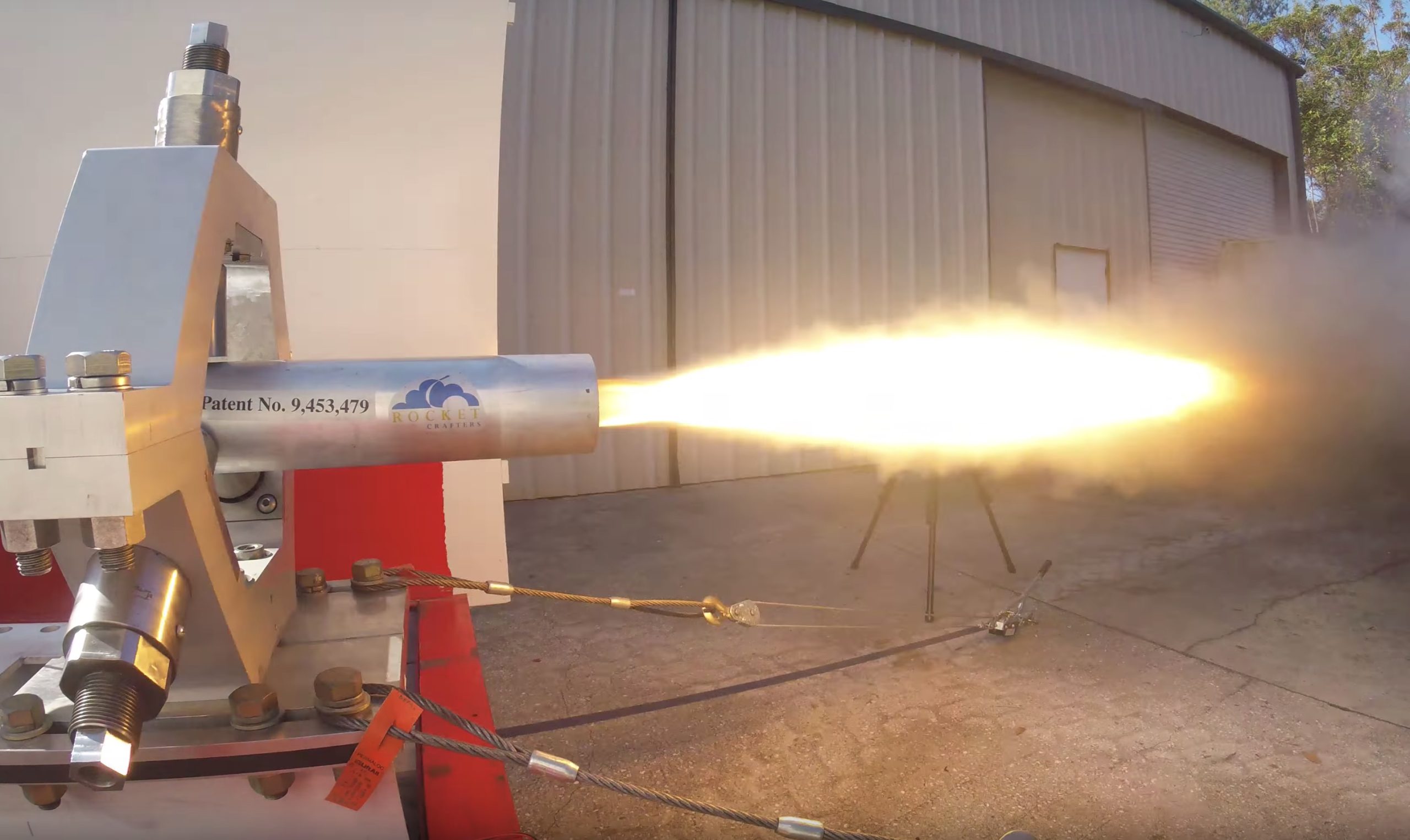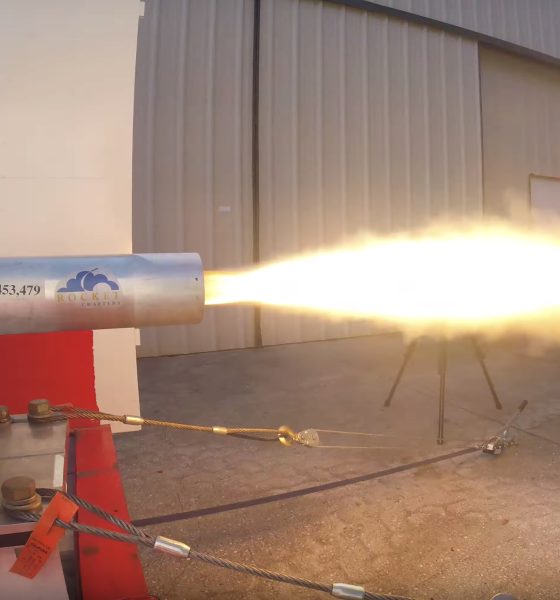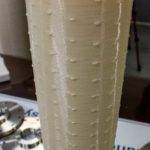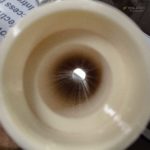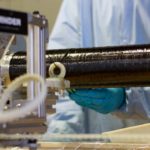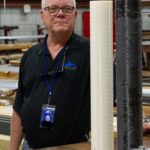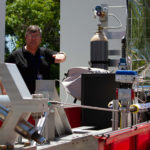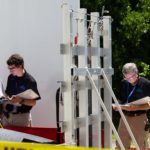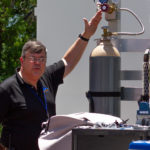I had a rare opportunity to visit Rocket Crafters, a small rocket company located in Cocoa, Florida, just 10 miles from the Kennedy Space Center, that is developing and testing what is known as ‘hybrid rocket engines’. These 3D printed engines are born in Colorado from a custom-made printer because none exist on the market that’s large enough to print these rocket engines that DARPA contracts them to build, with a $600,000 investment.
After the hybrid fuel grains are printed, they’re shipped to Rocket Crafters in Florida where they are further processed by wrapping them in carbon for additional strengthening and then test fired. The company is testing three engines per week at an industrial location in the city of Cocoa. The only requirement the City has for testing these engines is to keep the noise level below a certain decibel, over concerns of disruption to neighboring residential.
The engines, called fuel grains, are tubes made of ABS plastic, the same material LEGO are made of. The fuel grains are so safe, in fact, they can fly with them on airplanes as a carry on. They are specially shaped for the use of burning smoothly as a rocket engine, something only a printing process could form, which is a patented invention by Ronald Jones. The fuel grain needs an oxidizer in order to burn through, and without that, there’s really not much you can do with them because they’re just a tube of plastic.
- Rocket Crafters engine is a Patented printing process. (Tom Cross)
- A look inside the fuel grain. (Tom Cross)
- A fuel grain in the process of carbon-wrapping. (Tom Cross)
- Inventor, Ronald Jones. (Tom Cross)
When I arrived at Rocket Crafters the day of the test, I asked if I could set up my launchpad cameras to capture the flame of the engine during the test fire. Due to safety concerns over their oxidizer tanks that were already full, the team kindly advised against doing so. The oxidizer is nitrous oxide, also known as laughing gas at the dentist. Needless to say, it probably would have been incredibly funny had it sprung a leak while I was setting up my camera. The whole test stand sits on the back of a flat-bed trailer that’s ratcheted down to the concrete and protected by mobile steel walls on three sides.
- Rocket Crafters engine test stand. (Tom Cross)
- Technicians take readings from the gauges on the test stand. (Tom Cross)
CEO Sid Gutierrez, a former Space Shuttle Pilot, and Shuttle Commander touted the safety aspects of their rocket engine. “What you won’t see are cryogenics, bi-propellant liquid fuel engines, no signs saying explosives,” he said during the video conference. Rocket Crafters are carving their slice into the new wave of affordable launches for small-scale cube satellites and have grand plans of creating their own rocket called Intrepid consisting of multiple hybrid rocket engines burning simultaneously.
They brought me into their testing facility to showcase their fuel grains, carbon wrapping process, and most importantly a 10-second test fire of one of the engines from inside their control room. During the test, the engine could be heard through multiple block walls and doors as if it was just 10 feet away. The building didn’t shake, the sound was intense, though. The video on the screen doesn’t do it justice. The whole experience was pretty awesome.
Rocket Crafters still has a bit of work to do trying and testing new components before they’re ready to launch but they’ve already begun making prototypes of their full-scale engine. The day I was there, engineers were testing a nozzle made of a material they hadn’t tried before. “You don’t see many 15-person companies developing a rocket,” said Robert Fabian, SVP of Propulsion.
I’m no rocket expert, I’d be a rocket scientist instead of a photographer if so, but I learn a lot by doing this. I think this particular hybrid rocket engine would be perfectly suited for a prosumer market of amateur rocketry, especially considering how safe they are and non-toxic to the environment. The few amateur rocket enthusiasts I’ve asked about hybrid engines said they’d be great to have after they fix the flaws of hybrid engines.
Here’s a video of one of their engine tests:
https://youtu.be/BVPxbdkC1y8
Tom Cross

Lifestyle
Tesla Model S Plaid battles China’s 1500 hp monster Nurburgring monster, with surprising results
There is just something about Tesla’s tuning and refinement that makes raw specs seem not as game-changing.

The Tesla Model S Plaid has been around for some time. Today, it is no longer the world’s quickest four-door electric sedan, nor is it the most powerful. As per a recent video from motoring YouTube channel Carwow, however, it seems like the Model S Plaid is still more than a match for some of its newer and more powerful rivals.
The monster from China
The Xiaomi SU7 Ultra is nothing short of a monster. Just like the Model S Plaid, it features three motors. It also has 1,548 hp and 1,770 Nm of torque. It’s All Wheel Drive and weighs a hefty 2,360 kg. The vehicle, which costs just about the equivalent of £55,000, has been recorded setting an insane 7:04.957 at the Nurburgring, surpassing the previous record held by the Porsche Taycan Turbo GT.
For all intents and purposes, the Model S Plaid looked outgunned in Carwow’s test. The Model S Plaid is no slouch with its three motors that produce 1,020 hp and 1,420 Nm of torque. It’s also a bit lighter at 2,190 kg despite its larger size. However, as the Carwow host pointed out, the Model S Plaid holds a 7:25.231 record in the Nurburgring. Compared to the Xiaomi SU7 Ultra’s record, the Model S Plaid’s lap time is notably slower.
Real-world tests
As could be seen in Carwow’s drag races, however, Tesla’s tech wizardry with the Model S Plaid is still hard to beat. The two vehicles competed in nine races, and the older Model S Plaid actually beat its newer, more powerful counterpart from China several times. At one point in the race, the Xiaomi SU7 Ultra hit its power limit due to its battery’s temperature, but the Model S Plaid was still going strong.
The Model S Plaid was first teased five years ago, in September 2020 during Tesla’s Battery Day. Since then, cars like the Lucid Air Sapphire and the Xiaomi SU7 Ultra have been released, surpassing its specs. But just like the Model Y ended up being the better all-rounder compared to the BYD Sealion 7 and the MG IM6, there is just something about Tesla’s tuning and refinement that makes raw specs seem not as game-changing.
Check out Carwow’s Model S Plaid vs Xiaomi SU7 drag race video below.
Lifestyle
500-mile test proves why Tesla Model Y still humiliates rivals in Europe
On paper, the BYD Sealion 7 and MG IM6 promised standout capabilities against the Model Y.

BYD is seeing a lot of momentum in Europe, so much so that mainstream media has taken every opportunity to argue that the Chinese automaker has beaten Tesla in the region. But while BYD sales this year in Europe are rising and Tesla’s registrations remain challenged, the raw capabilities of vehicles like the Model Y are difficult to deny.
This was highlighted in a 500-mile challenge by What Car? magazine, which showed that the new Tesla Model Y is more efficient, cheaper to run, and more reliable than rivals like the BYD Sealion 7, and even the nearly 400 KW-charging MG IM6.
Range and charging promises
On paper, the BYD Sealion 7 and MG IM6 promised standout capabilities against the Model Y. The Sealion 7 had more estimated range and the IM6 promised significantly faster charging. When faced with real-world conditions, however, it was still the Model Y that proved superior.
During the 500-mile test, the BYD nearly failed to reach a charging stop, arriving with less range than its display projected, as noted in a CarUp report. MG fared better, but its charging speeds never reached its promised nearly-400 kW charging speed. Tesla’s Model Y, by comparison, managed energy calculations precisely and arrived at each stop without issue.
Tesla leads in areas that matter
Charging times from 25% to 80% showed that the MG was the fastest at 17 minutes, while Tesla and BYD were close at 28 and 29 minutes, respectively. Overall efficiency and cost told a different story, however. The Model Y consumed 19.4 kWh per 100 km, compared to 22.2 for MG and 23.9 for BYD. Over the full trip, Tesla’s charging costs totaled just £82 thanks to its supercharger network, far below BYD’s £130 and MG’s £119.
What Car? Magazine’s testers concluded that despite BYD’s rapid sales growth and the MG IM6’s seriously impressive charging speeds, Tesla remains the more compelling real-world choice. The Model Y just offers stability, efficiency, and a proven charging infrastructure through its Supercharging network. And as per the magazine’s hosts, the Model Y is even the cheapest car to own among the three that were tested.
Watch What Car? Magazine’s 500-mile test in the video below.
Lifestyle
Tesla Cybertruck slapped with world’s least intimidating ticket, and it’s pure cringe
One cannot help but cringe and feel second-hand embarrassment at the idea of a person just driving around with a stack of these babies.

A Cybertruck parked at Stanford Shopping Center in California was recently hit with what might be the most try-hard piece of paper ever slipped under a wiper blade: a “fake citation” accusing the driver of supporting a “fascist car.”
The note, shared on X by Tesla staff program manager Ryan Torres, quickly made the rounds on X, where it quickly gained attention as an example of how not to protest.
The world’s least intimidating ticket
According to the citation, the supposed “violation” was “driving a fascist car.” The remedial action? Take the bus, call an Uber, or ride a bike. The note also dubbed Elon Musk a “chainsaw-wielding Nazi billionaire.” Now, protests against Tesla and Elon Musk have become commonplace this year, but one cannot help but cringe and feel second-hand embarrassment at the idea of a person just driving around with a stack of fake anti-Tesla/Musk citations.
Torres pointed out the irony himself in his post on X. Tesla currently employs over 140,000 Americans, and SpaceX has put the U.S. firmly back at the top of space technology. As Torres put it, maybe the person behind the world’s least intimidating ticket should “read a book on innovation before vandalizing” other people’s property.
Peak performative clownery
Not to mention that the fake ticket’s logic collapses under its own weight. EVs like the Cybertruck are literally designed to reduce emissions, not “destroy the economy.” If anything, Tesla has bolstered the United States’ economy by fueling jobs in engineering, manufacturing, and clean energy. It’s not the first time a Tesla has been the target of vandalism or politically charged notes, but this one stands out for sheer cringe value.
Torres summed it up neatly: “Peak clownery.” On that point, at least, the citation earns full marks. In a way, though, perhaps cringe fake tickets are not as bad as the literal firebombs that were being thrown at Tesla stores and cars earlier this year because some critics were gleefully misinformed about Elon Musk.
